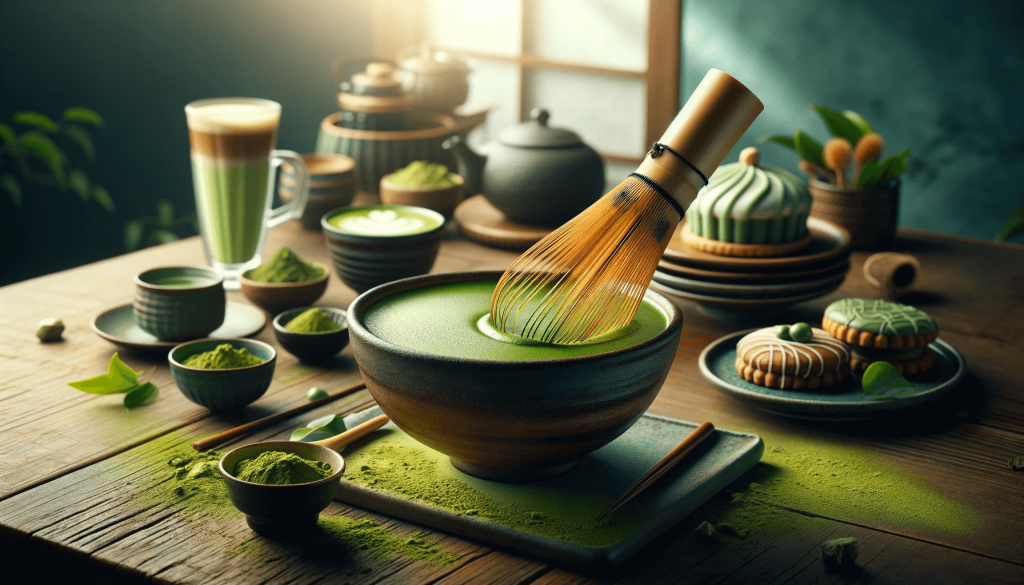
So, you’ve heard about matcha and are curious to dive into its green, frothy world, huh? Well, you’re in for a treat! Matcha isn’t just a tea; it’s a journey. Whether you’re a seasoned tea connoisseur or new to this green goodness, I’ll walk you through everything you need to know about matcha, from its origins to whipping up a perfect cup. And guess what? You don’t need to be a tea master to enjoy it, especially when using culinary matcha in various recipes that highlight its versatile flavor. Let’s get started!
Contents
- 1 Key Takeaways
- 2 Origins and Cultural Significance
- 3 Health Benefits and Nutritional Value
- 4 World of Matcha Powder: Types and Qualities
- 5 Types & Forms for the Best Matcha Powder: A Buyer’s Guide
- 6 Good Matcha: Decoding What Makes It Special
- 7 Products
- 8 The Art of Matcha Tea: Tradition Meets Modernity
- 9 The Ritual of Making Matcha: Tools and Techniques
- 10 Savoring a Cup of Matcha: Tips for the Ultimate Experience
- 11 Crafting the Perfect Latte: Incorporating Matcha for a Twist
- 12 Green Tea vs. Matcha Green Tea: Understanding the Differences
- 13 Exploring the Nutritional Profile of Matcha: A Superfood Spotlight
- 14 Matcha in Culinary Creations: Beyond the Tea Bowl
- 15 The Science of Matcha: How Processing Affects Quality and Flavor
- 16 Matcha and Mindfulness: The Zen of Preparing and Enjoying Tea
- 17 Navigating the World of Matcha Accessories: From Whisks to Bowls
- 18 Sustainable Sipping: Understanding the Environmental Impact of Matcha Production
- 19 The Global Journey of Matcha: From Japanese Farms to Your Cup
- 20 Conclusion
- 20.1 FAQ
- 20.2 What is Matcha?
- 20.3 What are the different grades of Matcha?
- 20.4 How do I make Matcha Tea or Latte at home?
- 20.5 Can Matcha replace my morning coffee?
- 20.6 Is it important to buy Organic Matcha?
- 20.7 How should I store Matcha to preserve its freshness?
- 20.8 Are there any health benefits associated with Matcha?
- 20.9 Can I cook or bake with Matcha?
- 20.10 Where does the best Matcha come from?
- 20.11 How do I find the best Matcha for me?
Key Takeaways
| Aspect | Details |
|---|---|
| What is Matcha? | Matcha is a fine, vibrant green tea powder famous for its use in the Japanese tea ceremony. |
| Origins | Originated in Japan, matcha has been an integral part of Japanese culture and Zen practices for centuries. |
| Health Benefits | Rich in antioxidants, matcha offers health benefits such as enhanced focus, energy boost, and potential weight loss, proving that matcha made a difference in one’s daily routine. |
| Types of Matcha | Matcha comes in mainly two grades: Ceremonial (for drinking) and Culinary (for cooking and baking). |
| Quality Indicators | High-quality matcha is characterized by a vibrant green color, a fine texture, and a balance between sweetness and umami. |
| Preparation | Traditional matcha preparation involves whisking the powder with hot water to create a frothy beverage. |
| Culinary Uses | Beyond tea, matcha is used in a variety of culinary creations, from desserts to savory dishes, adding flavor and color. |
Origins and Cultural Significance
Imagine you’re traveling back in time to ancient Japan, where matcha first made its grand entrance. This vibrant green powder was more than just a drink; it was a way of life, deeply entwined with the art of Zen Buddhism. Monks cherished matcha for its ability to enhance meditation, providing a unique blend of calmness and alertness. Fancy, right?
Health Benefits and Nutritional Value
Now, let’s talk perks! Matcha is like the superhero of teas, packed with antioxidants that help your body fight off the baddies (a.k.a. free radicals). It’s also got a bit of caffeine for a gentle energy boost, without the jitters of coffee. Plus, it’s rich in vitamins and minerals that keep your body feeling happy and healthy.
World of Matcha Powder: Types and Qualities
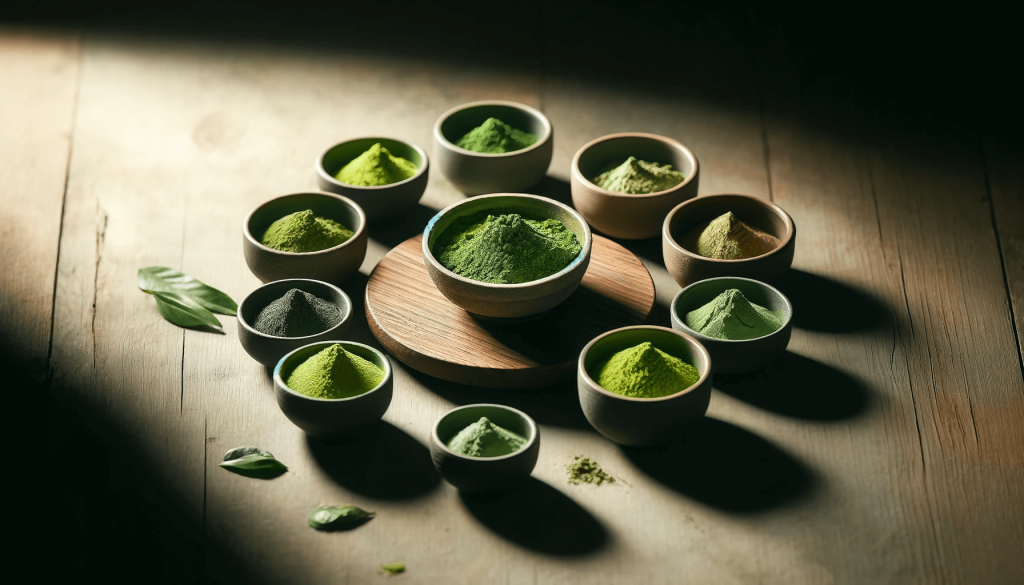
Ceremonial vs. Culinary Grades
Alright, here’s where it gets interesting. Not all matcha is created equal. There’s ceremonial grade, which is the top-notch stuff used in traditional tea ceremonies—smooth, refined, and full of umami. Then there’s culinary grade, the versatile buddy that’s great for cooking and baking. It’s a bit bolder and can hold its own when mixed with other ingredients.
Identifying High-Quality Matcha
Ever wondered how to spot the good stuff? High-quality matcha is a vibrant green color, smells fresh and grassy, and tastes smooth without being bitter. It’s like the difference between a top-shelf and a bottom-shelf drink; you can taste the quality matcha.
Types & Forms for the Best Matcha Powder: A Buyer’s Guide
| Type/Grade | Description |
|---|---|
| Matcha Latte | A latte beverage made with matcha powder |
| Matcha Powder | Ground matcha leaves, used as a base for drinks and food |
| Matcha Tea | Traditional matcha beverage, prepared with water |
| Ceremonial Grade Matcha | High-quality matcha used mainly for tea ceremonies is a testament to the great matcha tradition, blending both taste and ceremonial importance. |
| Jade Leaf Matcha | A brand of matcha |
| Stonemill Matcha, a great matcha choice for those who appreciate the finer details in the craft of tea. | Matcha ground using traditional stone mills |
| Uji Matcha | Matcha from the Uji region, known for its quality, is a prime example of great matcha that is sought after for both ceremonial and culinary purposes. |
What to Look for in Matcha Powder
When you’re on the hunt for matcha, keep an eye out for color, origin, and processing details. Bright green is good; dull green, not so much.
Recommended Brands and Where to Find Them
There are plenty of great brands out there, from traditional Japanese ones to newer Western favorites. You can find them online, in health food stores, or at specialty tea shops.
Good Matcha: Decoding What Makes It Special
Flavor Profile and Color
The best matcha has a complex flavor profile, with hints of sweetness, umami, and a touch of bitterness. And that color! It should be a lively, electric green.
Texture and Aroma
The texture should be silky and fine, like powdered sugar, and the aroma—fresh and inviting, like a spring morning in a lush garden.
Products
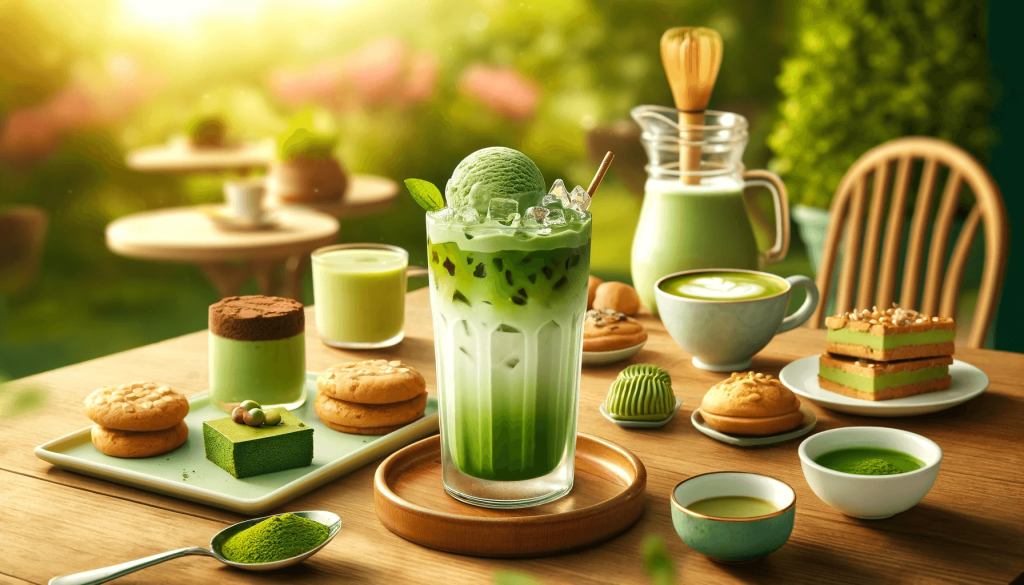
| Product | Description |
|---|---|
| Iced Matcha Latte, the perfect summer drink, combining the rich taste of matcha with the cooling and refreshing qualities of an iced beverage. | Chilled matcha latte |
| Matcha Ice Cream | Ice cream flavored with matcha |
| Matcha Cookies | Cookies made or flavored with matcha |
| Matcha Cake | Cake made or flavored with matcha |
| Matcha Boba | Boba tea made with matcha |
| Matcha Milk Tea | Milk tea prepared with matcha |
| Matcha Smoothie | Smoothie made with matcha |
| Matcha Cheesecake | Cheesecake flavored with matcha |
| Matcha Mochi | Japanese rice cakes made with matcha |
| Matcha Brownies, a perfect example of how culinary matcha can be used in innovative ways to infuse traditional desserts with the rich taste of matcha. | Brownies made or flavored with matcha |
| Matcha Tiramisu | Tiramisu dessert made with matcha |
The Art of Matcha Tea: Tradition Meets Modernity
Traditional Matcha Tea Preparation
The traditional way involves a bamboo whisk, a bowl, and a little elbow grease. It’s a calming ritual that connects you to the moment and to the centuries-old tradition of matcha preparation.
Modern Takes on Matcha
But hey, it’s the 21st century, right? Matcha lattes, smoothies, and even matcha-infused desserts are all the rage at the local coffee shop. And they’re delicious ways to enjoy the benefits of matcha in a modern twist.
The Ritual of Making Matcha: Tools and Techniques
Essential Tools for Making Matcha
To make traditional matcha, you’ll need a bamboo whisk (chasen), a tea bowl (chawan), and a scoop (chashaku). These tools aren’t just functional; they’re part of the experience, especially when preparing ceremonial matcha.
Step-by-Step Guide to the Traditional Method
Sifting your matcha into the bowl, adding water, and whisking it up into a frothy, creamy delight—it’s an art form, and with a bit of practice, you’ll be a pro in no time.
Savoring a Cup of Matcha: Tips for the Ultimate Experience
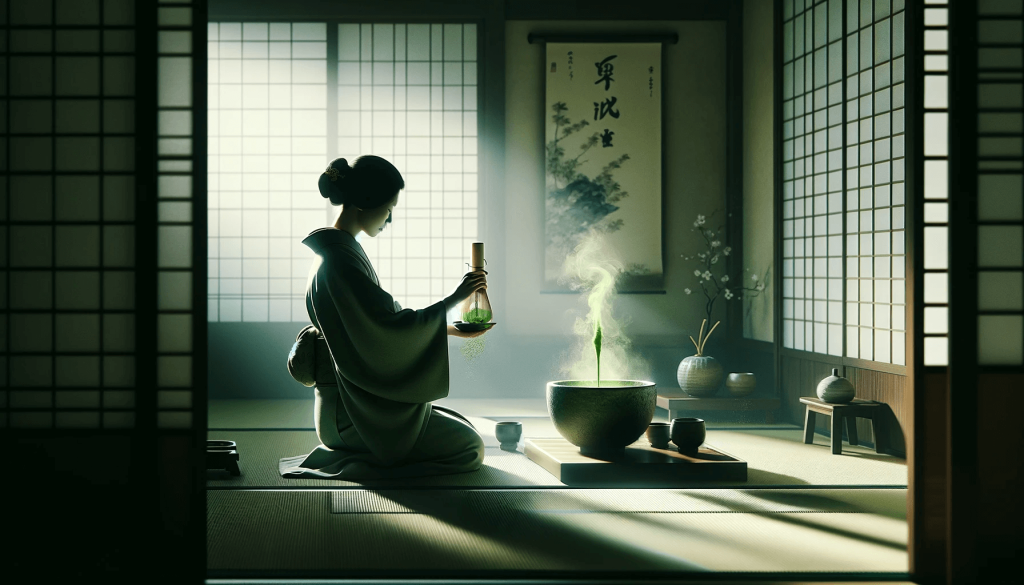
Best Practices for Preparation and Consumption
The key to a great cup of matcha? Quality powder, the right water temperature (not boiling!), and a bit of patience. Take your time and enjoy the process.
Pairing Matcha with Foods and Sweets
Matcha’s unique taste complements a wide range of foods. Think delicate sweets like mochi or bold flavors like dark chocolate. Experiment and find your favorite pairings!
Crafting the Perfect Latte: Incorporating Matcha for a Twist
Who says lattes can only be about coffee? Let’s shake things up a bit with a matcha latte, showcasing the versatile taste of matcha. Let’s shake things up a bit with a matcha latte, introducing a refreshing twist on traditional tastes by incorporating flavored matcha. It’s like giving your regular latte a green superhero cape. Pretty cool, right?
The Perfect Matcha Latte Recipe
Mixing up a matcha latte is like creating a little magic potion. Start with high-quality matcha, add a touch of sweetness (if that’s your thing), and top it off with steamed milk for a single serve delight. Voilà! You’ve got yourself a creamy, dreamy green masterpiece.
Creative Variations to Try
Feeling adventurous? Why not add a dash of vanilla, a sprinkle of cinnamon, or even a shot of espresso for a matcha latte with a kick? The possibilities are endless!
Green Tea vs. Matcha Green Tea: Understanding the Differences
So, green tea and matcha are the same thing, right? Not exactly. Let’s clear up the confusion.
Processing and Production
While both come from the same plant, the way they’re grown and processed is what sets them apart. Matcha takes a special spa treatment—shaded growth, handpicked leaves, and stone-ground into a fine powder. Fancy, huh?
Taste, Texture, and Health Benefits
Matcha packs a more concentrated punch in both flavor and nutrients compared to your standard green tea. It’s like comparing a gourmet meal to a quick snack.
Exploring the Nutritional Profile of Matcha: A Superfood Spotlight

Matcha isn’t just a pretty face; it’s loaded with goodies for your body.
Antioxidants and Health Benefits
This green powerhouse is brimming with antioxidants, helping your body keep its cool against stress and toxins. It’s like having a tiny, invisible army defending your health.
Matcha in a Balanced Diet
Incorporating matcha into your daily routine can be a game-changer. A cup in the morning or a matcha-infused snack can boost your energy levels and nutrient intake. Just remember, balance is key, and matcha is no different. Finding the right balance in flavor makes all the difference.
Matcha in Culinary Creations: Beyond the Tea Bowl
Matcha isn’t just for sipping; it’s a culinary chameleon, too.
Baking and Desserts
From vibrant green cakes to delicate cookies, matcha can add a touch of sophistication and a burst of flavor to your baked goods. It’s like a secret ingredient that wows every time.
Savory Dishes with a Matcha Twist
But wait, there’s more! Matcha can also find its way into savory dishes. A sprinkle over roasted vegetables or a dash in a marinade can add an unexpected and delightful twist.
The Science of Matcha: How Processing Affects Quality and Flavor
Ever wonder why matcha tastes so unique? Let’s nerd out for a moment and explore the science behind it.
From Shade-Grown Leaves to Fine Powder
The shade-growing process increases chlorophyll and amino acid levels in the leaves, giving matcha its vibrant color and umami flavor. It’s like giving the leaves a superpower boost.
The Chemistry of Matcha’s Unique Flavor
The combination of amino acids, caffeine, and catechins creates a complex flavor profile that’s rich, vegetal, and slightly sweet. It’s a symphony of tastes in every sip.
Matcha and Mindfulness: The Zen of Preparing and Enjoying Tea
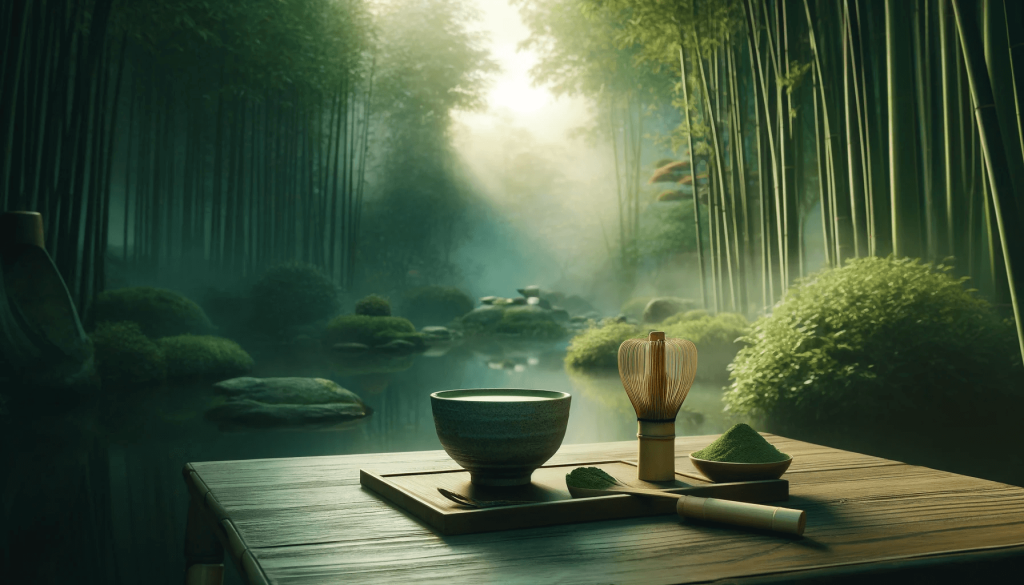
There’s something special about the ritual of preparing matcha. It invites calmness and mindfulness into your day, much like savoring a cup of quality matcha.
The Tea Ceremony: A Practice of Mindfulness
Participating in or even just observing a traditional tea ceremony can be a serene experience, connecting you with the present moment and the rich history of matcha.
Daily Rituals Incorporating Matcha
But you don’t need a formal ceremony to enjoy matcha mindfully. Preparing a cup can be a meditative moment in your day, a brief pause to relax and recharge.
Ready to dive deeper into the matcha experience? Let’s explore the tools of the trade.
The Traditional Tea Ceremony Set
A bamboo whisk, scoop, and bowl are the essentials. Each piece isn’t just functional; it’s a work of art, contributing to the beauty and tradition of matcha preparation.
Modern Tools for Matcha Preparation
But hey, we’re in the modern world, right? Electric frothers and contemporary matcha bowls can blend tradition with convenience, making your matcha ritual both authentic and accessible.
Sustainable Sipping: Understanding the Environmental Impact of Matcha Production
As we enjoy our matcha, it’s important to consider where it comes from, how it’s made, and the unique flavors of single origin matcha selections.
Eco-Friendly Farming Practices
Some matcha farms prioritize sustainability, using methods that protect the environment and ensure the health of the tea plants. It’s like giving back to Mother Nature.
Choosing Sustainable Matcha Brands
By selecting brands committed to eco-friendly practices, we can enjoy our matcha while supporting the planet. It’s a win-win!
The Global Journey of Matcha: From Japanese Farms to Your Cup

Matcha’s journey from leaf to latte is a fascinating tale of tradition, craftsmanship, and global appreciation.
The Cultivation of Matcha in Japan
The heart of matcha lies in Japan, where its cultivation and preparation have been refined over centuries. It’s a testament to the dedication and artistry of the tea farmers and artisans.
Thanks to its growing popularity, matcha has made its way across the globe, finding a place in our hearts (and cups) far from its Japanese origins. It’s a beautiful example of how something so traditional can become a beloved part of diverse cultures.
Conclusion
Embarking on the matcha journey means embracing both tradition and quality matcha. Choosing the right grade is crucial—ceremonial-grade for sipping in tranquility, and culinary-grade for vibrant, earthy additions to your favorite recipes. The best matcha, whether it’s for a morning latte or a culinary masterpiece, comes from authentic sources like organic Japanese farms and revered Kyoto-based tea companies such as Ippodo Tea, established since 1717.
Matcha isn’t just a tea; it’s a versatile ingredient that complements both the tea cup and the mixing bowl. Remember, a single teaspoon can transform your daily routine, offering a healthier, more grounded alternative to coffee, with the added benefit of antioxidants. Quality, tradition, and the right storage—keeping your matcha in the fridge—will ensure every cup embodies the rich, earthy essence of this traditional Japanese tea. Whether you’re a daily matcha drinker or new to its green allure, let each sip or bite connect you to centuries of Japanese tea culture.
FAQ
What is Matcha?
Matcha is a type of finely ground young tea leaves made from young tea leaves, specifically the Camellia sinensis plant. Unlike traditional tea, where the leaves are infused in water and then removed, matcha involves consuming the whole leaf in powdered form. This method of consumption traces back to traditional Japanese tea ceremonies and has gained popularity worldwide for its distinct flavor and health benefits.
What are the different grades of Matcha?
Matcha comes primarily in two grades: ceremonial-grade and culinary-grade. Ceremonial-grade matcha, such as the revered ummon matcha, is made from the youngest tea leaves and is best enjoyed whisked with water for a traditional tea. The taste of matcha in this form is unparalleled. It’s known for its vibrant color and delicate flavor, often on the sweeter side. Culinary-grade matcha, like the widely appreciated Jade Leaf Organic or Ito En matcha, is more versatile and can be used in cooking, baking, or for making lattes. It’s a bit stronger in flavor, making it ideal for mixing with milk or other ingredients.
How do I make Matcha Tea or Latte at home?
To make a traditional matcha tea, you only need one teaspoon of matcha green tea powder, hot water, and a matcha whisk. Sift the matcha into a bowl to remove clumps, then add hot water and whisk vigorously in a zigzag motion until frothy. For a matcha latte, replace some of the water with steamed milk, using a milk frother to achieve a creamy texture. Both drinks can be enjoyed hot or cold.
Can Matcha replace my morning coffee?
Yes, many people find matcha a great alternative to coffee. Although it contains less caffeine, matcha’s energy boost is more even and sustained, thanks to the amino acid L-Theanine. This means you can enjoy a boost of energy without the jitters or crash often associated with coffee.
Is it important to buy Organic Matcha?
While the choice between organic and non-organic matcha comes down to personal preference, organic matcha ensures that the tea leaves are grown without synthetic fertilizers or pesticides. Brands like Jade Leaf Organic offer high-quality organic Japanese matcha that provides peace of mind regarding purity and sustainability.
How should I store Matcha to preserve its freshness?
Matcha should be stored in an airtight container in the fridge to preserve its freshness, color, and flavor. This is particularly important for high-quality matcha to maintain its delicate taste and prevent oxidation.
Are there any health benefits associated with Matcha?
Matcha is rich in antioxidants, which help neutralize harmful free radicals in the body, reducing the risk of chronic diseases including heart disease. The presence of L-Theanine also promotes relaxation and well-being, making matcha not only a delightful drink but also a beneficial one for your health.
Can I cook or bake with Matcha?
Absolutely! Matcha culinary grade is specifically designed for use in recipes. Its robust flavor complements a variety of dishes, from sweet treats like matcha-infused cookies and cakes to savory dishes. Think of it as a versatile ingredient, much like cocoa powder, that can add a unique twist to your culinary creations.
Where does the best Matcha come from?
The best matcha is typically sourced directly from Japan, the country of origin for this exquisite tea, often boasting a single origin tag to highlight its quality. Renowned regions include Uji, Aichi, and Kagoshima. Brands like Remy Morimoto Park and Ummon Matcha pride themselves on offering single-origin, high-quality matcha that reflects the traditional techniques and flavors of Japanese jade leaf matcha.
How do I find the best Matcha for me?
Finding the best matcha depends on your intended use, whether it be for ceremonial matcha or culinary grade matcha. For traditional tea drinking, ceremonial-grade matcha offers the most authentic experience. For culinary purposes, culinary-grade matcha provides the necessary flavor profile. Exploring different brands and grades, such as ceremonial ummon matcha or culinary Jade Leaf Organic, can help you discover the matcha that best suits your taste and needs.